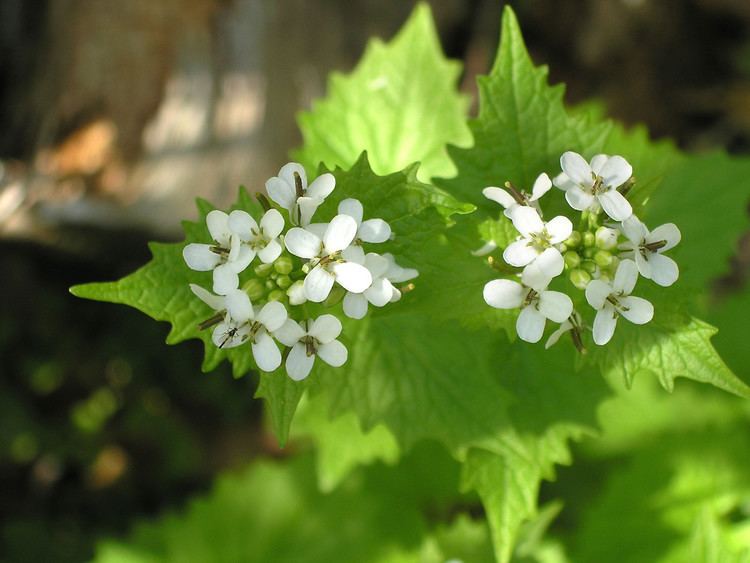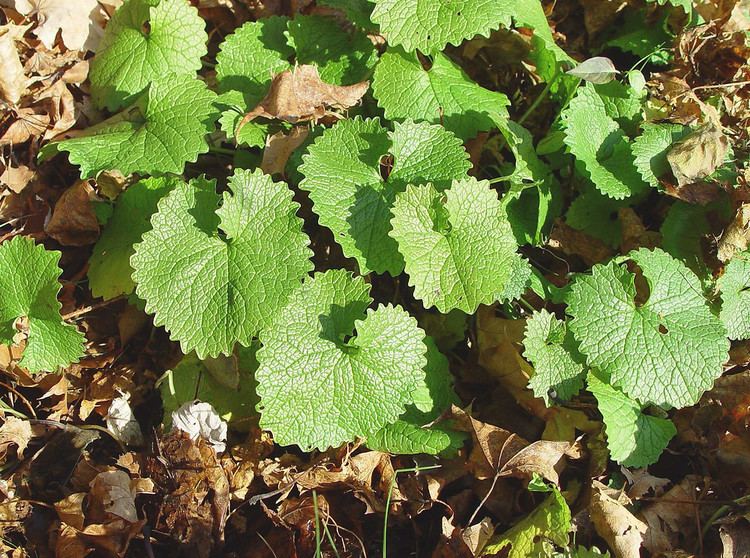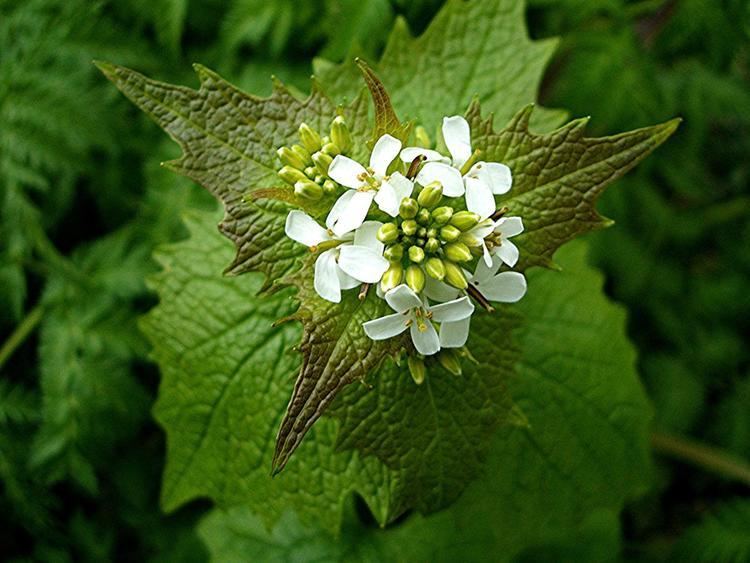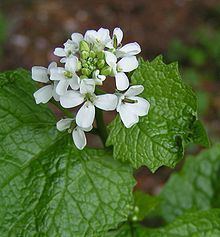Rank Species | Genus Alliaria Higher classification Alliaria | |
Similar Cuckoo Flower, Ground Elder, Ficaria verna, Common Chickenweed, Herb Bennett | ||
Alliaria petiolata is a biennial flowering plant in the Mustard family, Brassicaceae. It is native to Europe, western and central Asia, and northwestern Africa, from Morocco, Iberia and the British Isles, north to northern Scandinavia, and east to northern Pakistan and western China (Xinjiang).
Contents
- Wild plant foraging journey s 40 more habitats alleyway alliaria petiolata almost ineveitably
- Description
- Cultivation and uses
- As an invasive species
- Control strategies
- References

In the first year of growth, plants form clumps of round shaped, slightly wrinkled leaves, that when crushed smell like garlic. The next year plants flower in spring, producing cross shaped white flowers in dense clusters. As the flowering stems bloom they elongate into a spike-like shape. When blooming is complete, plants produce upright fruits that release seeds in mid-summer. Plants are often found growing along the margins of hedges, giving rise to the old British folk name of Jack-by-the-hedge. Other common names include Garlic Mustard, Garlic Root, Hedge Garlic, Sauce-alone, Jack-in-the-bush, Penny Hedge and Poor Man's Mustard. The genus name Alliaria, "resembling Allium", refers to the garlic-like odour of the crushed foliage. Some people give the species name Alliaria officinalis for this plant.

All parts of the plant, including the roots, give off a strong odour. In 17th century Britain it was recommended as a flavouring for salt fish. It can also be made into a sauce for eating with roast lamb or salad. Early European settlers brought the herb to the New World to use as a garlic type flavoring, and as a good source of vitamins A and C. The herbs medicinal purposes include use as a disinfectant, a diuretic, and sometimes being used to treat gangrene and ulcers. The herb was also planted as a form of erosion control.

The plant is classified as an invasive species in North America. Since being brought to the United States by settlers, it has naturalized and expanded its range to include most of the Northeast and Midwest, as well as southeastern Canada. It is one of the few invasive herbaceous species able to dominate the understory of North American forests and has thus reduced the biodiversity of many areas.

Wild plant foraging journey s 40 more habitats alleyway alliaria petiolata almost ineveitably
Description

It is a herbaceous biennial plant growing from a deeply growing, thin, white taproot that is scented like horseradish. In the first year, plants appear as a rosette of green leaves close to the ground; these rosettes remain green through the winter and develop into mature flowering plants the following spring. Second year plants grow from 30–100 cm (rarely to 130 cm) tall. The leaves are stalked, triangular to heart-shaped, 10–15 cm long (of which about half being the petiole) and 5–9 cm broad, with a coarsely toothed margin. The flowers are produced in spring and summer in button-like clusters. Each small flower has four white petals 4–8 mm long and 2–3 mm broad, arranged in a cross shape. The fruit is an erect, slender, four-sided pod 4 to 5.5 cm long, called a silique, green maturing pale grey-brown, containing two rows of small shiny black seeds which are released when the pod splits open. A single plant can produce hundreds of seeds, which scatter as much as several meters from the parent plant.
Depending upon conditions, garlic mustard flowers either self-fertilize or are cross-pollinated by a variety of insects. Self-fertilized seeds are genetically identical to the parent plant, enhancing its ability to colonize an area where that genotype is suited to thrive.
Cultivation and uses
Garlic mustard is one of the oldest discovered spices to be used in cooking in Europe. Evidence of its use has been found from archeological remains found in the Baltic, dating back to 6100-5750 BP.
The chopped leaves are used for flavoring in salads and sauces such as pesto, and sometimes the flowers and fruit are included as well. These are best when young, and provide a mild flavour of both garlic and mustard. The seeds are sometimes used to season food directly in France. Garlic mustard was once used medicinally as a disinfectant or diuretic, and was sometimes used to heal wounds.
Sixty nine insect herbivores and seven fungi are associated with garlic mustard in Europe. The most important groups of natural enemies associated with garlic mustard were weevils (particularly the genus Ceutorhynchus), leaf beetles, butterflies, and moths, including the larvae of some moth species such as the Garden Carpet moth.
The small white flowers have a rather unpleasant aroma which attracts midges and hoverflies, although the flowers usually pollinate themselves. In June the pale green caterpillar of the orange tip butterfly (Anthocharis cardamines) can be found feeding on the long green seed-pods from which it can hardly be distinguished.
In North America, the plant offers no known wildlife benefits and is toxic to larvae of certain butterfly species that lay eggs on the plants, as it is related to native mustards. Native species, including two stem-mining weevils, a stem-mining fly, a leaf-mining fly, a scale insect, two fungi, and aphids (taxonomic identification for all species is pending) were found attacking garlic mustard in North America. However, their attacks were of little consequence to plant performance or reproduction of garlic mustard.
As an invasive species
Garlic mustard was introduced in North America as a culinary herb in the 1860s and is an invasive species in much of North America. As of 2006, it is listed as a noxious or restricted plant in the US states of Alabama, Connecticut, Massachusetts, Minnesota, New Hampshire, Oregon, Vermont, West Virginia and Washington., and occurs in 27 midwestern and northeastern states in the US, and in Canada. Like most invasive plants, once it has an introduction into a new location, it persists and spreads into undisturbed plant communities. In many areas of its introduction in Eastern North America, it has become the dominant under-story species in woodland and flood plain environments, where eradication is difficult.
The insects and fungi that feed on it in its native habitat are not present in North America, increasing its seed productivity and allowing it to out-compete native plants.
Garlic mustard produces allelochemicals, mainly in the form of the compounds allyl isothiocyanate and benzyl isothiocyanate, which suppress mycorrhizal fungi that most plants, including native forest trees, require for optimum growth. However, allelochemicals produced by garlic mustard do not affect mycorrhizal fungi from garlic mustard's native range, indicating that this "novel weapon" in the invaded range explains garlic mustard's success in North America. Additionally, because white-tailed deer rarely feed on garlic mustard, large deer populations may help to increase its population densities by consuming competing native plants. Trampling by browsing deer encourages additional seed growth by disturbing the soil. Seeds contained in the soil can germinate up to five years after being produced (and possibly more). The persistence of the seed bank and suppression of mycorrhizal fungi both complicate restoration of invaded areas because long-term removal is required to deplete the seed bank and allow recovery of mycorrhizae.
Garlic mustard produces a variety of secondary compounds including flavonoids, defense proteins, glycosides, and glucosinolates that reduce its palatability to herbivores. Research published in 2007 shows that, in northeastern forests, garlic mustard rosettes increased the rate of native leaf litter decomposition, increasing nutrient availability and possibly creating conditions favorable to garlic mustard's own spread.
Control strategies
Preventing seed production and depletion of the soil seed bank are key to eradicating infestations. Non chemical control includes removal by hand-pulling or cutting at the base; mowing; burning; or manipulation of the environment to reduce light. Pulling is more effective if the root is removed. Garlic mustard may invade forested sites where the canopy has been disturbed, so management by planting or encouraging other plants to intercept light will aid control, or prevent new infestations. Control is best in early spring before flowering. Removed plants should be bagged or burned, as seeds or roots may survive composting.
Chemical control may be achieved by foliar application with a number of different herbicides. Timing herbicide applications to early spring or late fall may protect native or desirable plants in the same locations as garlic mustard is generally active across a longer season than other plants in northern temperate climates. All methods of weed control must be repeated for 3–4 years or longer to be effective—as seeds germinate, or as surviving roots re-sprout the infestation may be quickly re-established.
Several species from its native range are being tested for use as potential biological control agents. In particular, five weevil species from the genus Ceutorhynchus and one flea beetle were selected as candidates during preliminary testing.
